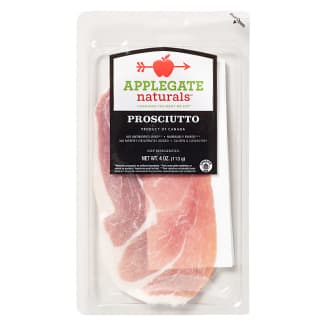Reviews You Can Trust.
See Why.
Supermarket Prosciutto
A new surge of grab ’n’ go packages means you no longer have to wait at the deli counter to have this cured pork sliced by hand. But does “convenience” prosciutto make the cut?
Top Picks

WinnerVolpi Traditional Prosciutto
“Tender” and “buttery” with a “very nice porky complexity” and a “salty punch” that came from having one of the highest sodium levels in the lineup, our top choice was “sweet, rich-tasting, and acorn-y.” Tasters were wowed by its “silky,” “ultrasupple” texture that was highlighted by the meat being sliced very thinly. Fried up in chicken saltimbocca, it continued to win fans: “The prosciutto really elevated the dish . . . with rich, meaty flavor.”

Best BuyDel Duca Prosciutto
With a “nice porky sweetness” and “clean” but “intense” flavor, this prosciutto was one of the most thickly sliced in the lineup, but its ample moisture also gave it a “supple,” “silky” texture. In saltimbocca, it was lauded for its “rich pork belly flavor.” In sum: “Buttery, nutty, complex. This is good stuff.”
Sign up for the Well-Equipped Cook newsletter
Shop smarter with our ATK Reviews team's expert guides and recommendations.
What You Need to Know
Not too long ago, the only way to buy prosciutto was to find an Italian market and wait while someone sliced imported prosciutto di Parma or prosciutto di San Daniele by hand. What you get is sublime: rosy, supple slices of pork that are at once salty, tangy, and sweet and incredibly complex.
But since American and Canadian producers have gotten into the game, this cured pork is easier to come by. Many sell their prosciutto in supermarkets in grab ’n’ go packages, making it as easy to buy as bologna.
Since it can be hard to find hand-sliced Italian prosciutto at smaller supermarkets, we were happy about the meat’s wider availability. But we also couldn’t help wondering if these presliced North American prosciutti retained the same depth of flavor and soft texture that we expect from Italian prosciutto that’s sliced to order. Price was also on our radar: Purchasing nine of these products confirmed that presliced non-Italian prosciutto is no bargain. The per-pound prices ranged from just over $19 to a whopping $58-and-change. The numbers are even more staggering when compared with the cost of prosciutto di Parma and prosciutto di San Daniele: about $23 and $20 per pound, respectively.
As for flavor, we tried them plain and also seared in chicken saltimbocca. The good news: We liked most of the samples. A few even boasted some of the complexity and silky texture that we expect from the Italian imports. The three we panned not only lacked porkiness but also carried a pronounced spice flavor that tasters compared to salami. To figure out what might separate the winners from the losers, we started by learning how prosciutto is made on its home turf.
It’s in the Air
Italians have been curing ham for more than 2,000 years, most notably around Parma. Producers in this city still make prosciutto under the eye of a consortium that sears Parma’s crown icon onto every approved ham. Prosciutto di San Daniele, from the Friuli region, has its own consortium and ham leg–shaped icon. Both are designated “PDO”—Protected Designation of Origin—by the European Union, meaning they are exceptional regional products with exclusive rights to their names.
Producers in both regions use the same basic method: After slaughtering pigs, they salt and hang the legs for a minimum of 12 months. The meat’s flavor concentrates with age, as prosciutto loses up to 30 percent of its weight in moisture during curing.
Age gave us our first clue as to the flavor differences among our non-Italian prosciuttos. Whereas the U.S. government requires that dry-cured ham from Italy be aged for at least 400 days (a little more than 13 months), it doesn’t set a minimum age for ham dry-cured in North America. Two of the hams in our lineup were aged for less than 9 months—and tasters noticed, describing them as “not very complex.”
Adding Up Additives
From there, we checked the ingredient labels for clues and homed in on a big difference between the three products that tanked and the ones we recommend. While our top six producers follow the Italians and use nothing but pork and salt, the makers of two of the losing products add nitrates—preservatives that turn the meat’s color bright red and boost its savory flavor so that it tastes like “salami.” These two makers further muddy the flavor of their prosciutti by including unspecified “natural flavorings,” sugar, sodium nitrite (another preservative and curing agent), sodium ascorbate (another preservative), and lactic acid starter culture.
That last ingredient turned out to be another important factor. Lactic acid–producing bacteria, or lactobacillus, launch the fermentation process that breaks down the meat’s proteins into savory peptides and amino acids, which over time help develop the meat’s famously complex depth. In a high-quality prosciutto, the bacteria is allowed to develop naturally over time. This produces a wide range of different bacteria that boost complexity. But some producers shortcut the process by adding lactic acid starter cultures containing a single strain of bacteria. Flavor suffers as a result, leading to the one-note tanginess we noticed in our least favorite brands.
Not surprisingly, sodium was another key factor in our likes and dislikes. Most of our favorite prosciutti (including our winner) were salty. What did surprise us was that the texture of the hams mattered at least as much as their flavor. The most telling examples were the two from one manufacturer. Even though these prosciutti won raves for their “lush” pork flavor, they fell in the rankings. Why? These hams were among the driest and most thickly sliced—a fatal combination that made them taste “chewy” and “jerky-like.” (Thicker-sliced hams with more moisture fared better.) Meanwhile, low-moisture hams that were sliced thinner delivered that ideal combination of complex flavor and supple texture.
Such was the case with our winner. Not only were these low-moisture slices among the thinnest of the lot, but this high-salt prosciutto with “porky complexity” was well worthy of any salumi plate and can be quickly picked up at any supermarket. Meanwhile, for convenience prosciutto that doesn’t cost an arm and, um, a leg, our Best Buy boasts “supple” slices that taste “complex” and a bit less salty.
America's Test KitchenWatch Now
Everything We Tested
Recommended

WinnerVolpi Traditional Prosciutto

Best BuyDel Duca Prosciutto

Citterio All Natural Prosciutto

Bellentani Prosciutto

La Quercia Berkshire Prosciutto
Recommended with reservations

La Quercia Prosciutto Americano
Not Recommended

Applegate Naturals Prosciutto

Columbus Prosciutto

Dietz & Watson Prosciutto
*All products reviewed by America’s Test Kitchen are independently chosen, researched, and reviewed by our editors. We buy products for testing at retail locations and do not accept unsolicited samples for testing. We list suggested sources for recommended products as a convenience to our readers but do not endorse specific retailers. When you choose to purchase our editorial recommendations from the links we provide, we may earn an affiliate commission. Prices are subject to change.
Reviews You Can Trust
The mission of America’s Test Kitchen Reviews is to find the best equipment and ingredients for the home cook through rigorous, hands-on testing. Have a question or suggestion? Send us an email at atkreviews@americastestkitchen.com. We appreciate your feedback!
The Expert

byLisa McManus
Executive Editor, ATK Reviews
Lisa is an executive editor for ATK Reviews, cohost of Gear Heads on YouTube, and gadget expert on TV's America's Test Kitchen.
Lisa McManus is an executive editor for ATK Reviews, cohost of Gear Heads on YouTube, host of Cook's Illustrated's Equipment Review videos, and a cast member—the gadget expert—on TV's America's Test Kitchen. A passionate home cook, sometime waitress, and longtime journalist, she graduated from Columbia University's Graduate School of Journalism and worked at magazines and newspapers in New York and California before returning like a homing pigeon to New England. In 2006 she got her dream job at ATK reviewing kitchen equipment and ingredients and has been pretty thrilled about it ever since. Her favorite thing is to go somewhere new and find something good to eat.
Reviews You Can Trust.
See Why.



